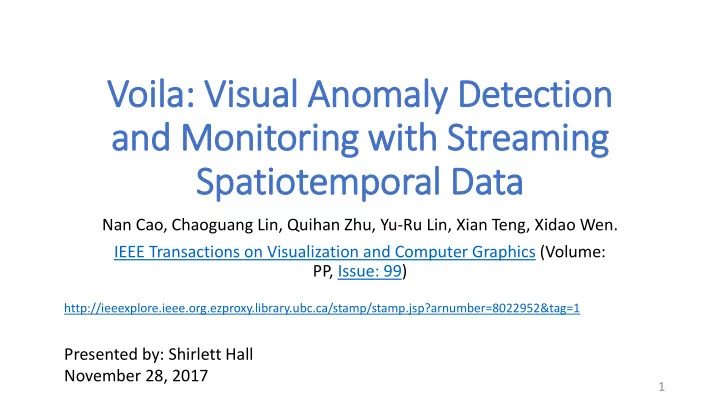

Voila: Vis isual Anomaly Detection and Monitoring wit ith Streaming Spatiotemporal Data Nan Cao, Chaoguang Lin, Quihan Zhu, Yu-Ru Lin, Xian Teng, Xidao Wen. IEEE Transactions on Visualization and Computer Graphics (Volume: PP, Issue: 99) http://ieeexplore.ieee.org.ezproxy.library.ubc.ca/stamp/stamp.jsp?arnumber=8022952&tag=1 Presented by: Shirlett Hall November 28, 2017 1
Im Implementation of f the map visualization system High Level Goals: • To process large scale, dynamic streaming data to detect anomalies • To allow human inspection and interpretation to guide final machine processes High Level Features: • Online Data Processing Pipeline that remains connected to data inputs • Uses a tensor-based algorithm to produce descriptive patterns over time and space • Incorporates unsupervised Machine Learning Techniques during human interactions • Shifts between map modes dependent on user goals 2
What: Data • GIS Data in big data scenarios • Transformed into a sequence of tensor time series at the granular level of an hour, a day, a week, or month 3
Why: Abstract Tasks • In a specific point in time, identify spatial locations and objects • Direct user’s attention to potentially significant anomaly instances • Compare behaviors at the same or different time intervals using user judgement 4
Why: Domain Tasks 1. Use anomaly detection algorithm against the multi-faceted data 2. Create rich-context visualizations that show suspicious patterns from the tensor analysis • Overview -> ranking -> link to raw data • Showing patterns -> comparing patterns -> external memorization 3. Apply or update Bayesian rules as users re-order anomalous patterns by degree of importance 5
Why: Domain Tasks, cont’d 6
How: Facets 7
How: Heatmap in Anomaly Detection Mode 8
How: Heatmap in Context xt Mode 9
Voila - Short Video showing Application 10
Analysis Summary ry System Voila What:Data Streaming, dynamic GIS with spatial location and objects What: Derived Tensor with features, space and time as quantitative attributes Apply anomaly detection, show suspicious patterns, compare historical patterns, allow analysis, process user feedback, update machine learning Why: Tasks algorithm Dense spatial area using rectangular layered glyphs; colormaps with diverging hues and sequential saturation levels; and popouts/tooltips on How: Encode fields Multiform linked layouts including 2 views with a main map and a less detailed map to show context; time series showing area history; tabular How: Facet chart showing anomalies; panel showing ranking of multiple regions How: Reduce Filtering How: Manipulate Selection and highlighting, pan, zoom, brush up to 311 grids on a map, over 100 million instances, ex. volume of traffic as 11 Scale: attribute
Evaluation and Next Steps: Authors’ Perspective • The tensor detection method produced more satisfactory positive identification rates than other baseline methods • With the aid of the system’s visual tools, users are well prepared to fixate on only suspicious events • Since the initial visualization seems overwhelming at first glance, need tutorials • More visual clues • Support for Fact Checking • Adaptively determine granularity with respect to time • Embed forecasting and prediction capability 12
Additional Critique • Good that they have included a human in loop • Channels are noticeable and fairly effective for the intended purpose with some exceptions, ex. rainbow like color map for z-scores • The purpose of each juxtaposed view is not clear to a novice user • The authors should have more than one domain expert provide feedback • When a particular anomaly is noted as being normal, then this may increase the likelihood that false negatives occur in the future • Size of the q inside the glyph, should be a number • No mention of the system requirements to process and store so much data and the speed of the algorithm 13
Recommend
More recommend